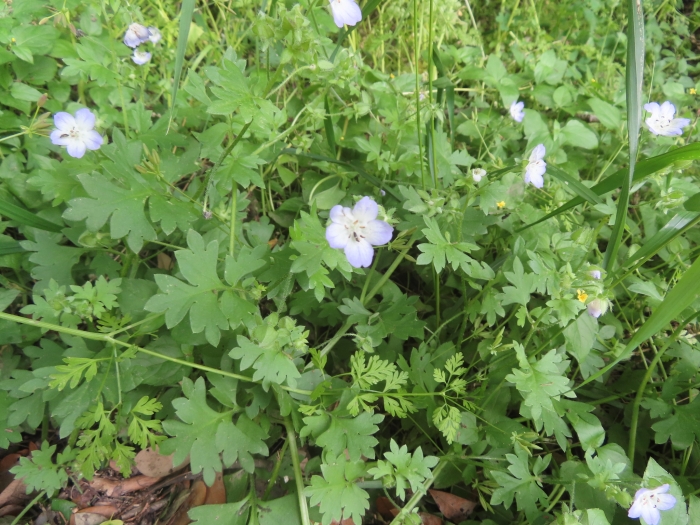Large-Flower Baby-Blue-Eyes
(Nemophila phacelioides)
Large-Flower Baby-Blue-Eyes (Nemophila phacelioides)
/
/

Ken Clark
CC BY 4.0
Image By:
Ken Clark
Recorded By:
Copyright:
CC BY 4.0
Copyright Notice:
Photo by: Ken Clark | License Type: CC BY 4.0 | License URL: http://creativecommons.org/licenses/by/4.0/ | Rights Holder: Ken Clark | Publisher: iNaturalist | Date Created: 2024-04-12T19:05:36-07:00 |












Estimated Native Range
Summary
Nemophila phacelioides, commonly known as Large-flower Baby-blue-eyes or Texas Baby-blue-eyes, is an herbaceous annual plant native to woodland openings and grassy slopes in the South Central United States, specifically in Arkansas, Oklahoma, and Texas. It typically grows to about 10 inches tall and can spread to form a dense ground cover. The plant is noted for its striking spring blooms, which are large and showy with a distinctive blue or purple outer edge that fades to white towards the center. Each flower, about an inch wide, consists of five petals and is highly attractive to pollinators.
In cultivation, Large-flower Baby-blue-eyes is valued for its ease of maintenance and ability to thrive in part shade to full shade conditions. It prefers slightly moist, well-drained soils with a sandy or silty texture. Gardeners often use it for border planting, in wildflower gardens, or as a charming addition to rock gardens. While it requires regular watering, especially in dry conditions, it is generally not demanding and can reseed itself under favorable conditions. However, it is susceptible to fungal diseases in overly wet or poorly drained soils. This plant is not known for aggressive roots or significant pest problems, making it a delightful choice for gardeners seeking a low-maintenance yet visually appealing annual.CC BY-SA 4.0
In cultivation, Large-flower Baby-blue-eyes is valued for its ease of maintenance and ability to thrive in part shade to full shade conditions. It prefers slightly moist, well-drained soils with a sandy or silty texture. Gardeners often use it for border planting, in wildflower gardens, or as a charming addition to rock gardens. While it requires regular watering, especially in dry conditions, it is generally not demanding and can reseed itself under favorable conditions. However, it is susceptible to fungal diseases in overly wet or poorly drained soils. This plant is not known for aggressive roots or significant pest problems, making it a delightful choice for gardeners seeking a low-maintenance yet visually appealing annual.CC BY-SA 4.0
Plant Description
- Plant Type: Herb
- Height: 0.5-1.5 feet
- Width: 1-2 feet
- Growth Rate: Moderate
- Flower Color: Blue, Purple, White
- Flowering Season: Spring
- Leaf Retention:
Growth Requirements
- Sun: Part Shade
- Water: Medium
- Drainage: Fast, Medium, Slow
Common Uses
Bee Garden, Border Plant, Butterfly Garden, Low Maintenance, Potted Plant
Natural Habitat
Woodland openings and grassy slopes in the South Central United States
Other Names
Common Names: Texas Nemophila
Scientific Names: , Nemophila phacelioides, Nemophila hirsuta, Nemophila nemorosa, Nemophila nemorosa, Nemophila nuttallii, Nemophila pilosa, Viticella phacelioides,
GBIF Accepted Name: